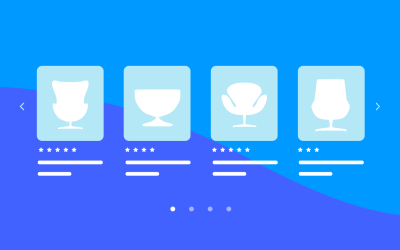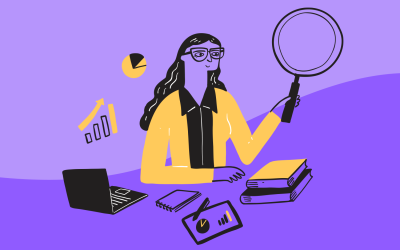Ever wondered how Facebook and Instagram get their UX so right? Researcher Jen Romano spills the beans on her working day at the social media giant
Jen Romano has a resumé that makes your eyes water. With a Ph.D. and M.A. in Applied/Experimental Psychology and a B.A. in Psychology, she worked in UX at top-notch government agencies before settling into her current role – UX Researcher at Facebook/Instagram.
She’s also the current President of the International UXPA, and co-author of Usability Testing for Survey Research, and Eye Tracking in User Experience Design. Phew!
The Justinmind team was thrilled when Jen found time somewhere in her crammed schedule to chat with us about her work at Facebook and Instagram. Despite some projects being hush-hush, Jen gave us a great glimpse into the User Researcher role at the social media behemoth.
She also introduced us to the world of eye-tracking for user research, and gave her take on women in tech right now.
First off, Jen – eye tracking. How did you get into it and what are the benefits?
I kind of stumbled into it! When I was in grad school, there was a posting for an internship at the US Census Bureau going round my department. I was studying psychology, specialised in applied experimental psychology and cognitive aging.
I didn’t know anything about usability and user experience, but this internship posting required skills in running participants, designing studies, reporting, presenting to stakeholders. And these were things that I knew how to do from my grad experience.
In the posting it also mentioned eye tracking. I didn’t know what it was but many of my peers were doing things like EEG and FMRI and I liked those methods for understanding psychology. I was intrigued by the eye-tracking methodology.
I ended up doing the internship at the Census Bureau and then doing a post doctoral position; that’s really where I learned all about usability and eye tracking.
While I was at the Census Bureau they started working with heat maps, and I took it upon myself to really understand what the quantitative data was showing us and what we could really learn about how people were interacting with the interface.
With eye-tracking, we get a really detailed picture of what people are doing when they look at an interface
What I learned is that, with eye-tracking, we get a really detailed picture of what people are doing when they look at an interface. The order at in which users look at things, if they miss something, if something is really distracting. They may continuously look at something and never actually click on it.
These are things that are really difficult if not impossible to understand when you don’t have eye tracking. You can ask people but you don’t know when they really see things.
It’s difficult to accurately understand how people are processing the interface and what is capturing attention just by asking them; it’s just not a good measure. Eye tracking enables us to understand those things accurately
If eye tracking has so many benefits, why do you think it’s still seen as an optional rather than essential part of usability testing?
That’s a great question. I’d love to ask others why they don’t use it. I think one reason is that people are not trained in eye tracking, so it’s not on their radar. Once they start to use it, many people continue to do so because of the value it adds.
Also, eye tracking entails additional equipment, additional things to worry about, additional things you need to put in front of the participant. I think researchers find that without eye tracking they get enough information to inform changes. They haven’t seen the value yet.
What are your tips for people looking to incorporate eye tracking into their usability testing?
Step one, just have live streaming so stakeholders can see where people are looking. Don’t even worry about the quantitative analysis or the data when you’re getting started, just have live streaming. If you want to, you can include short video clips in your reporting of when people look at things, or when they miss something.
That qualitative information alone is really valuable. I do that to this day when I need to share results quickly. That would be my recommendation for people who want to learn the method. Don’t make it too complicated, start with the informative stuff you can do off the bat.
Can you tell us how you guys conduct user research projects at Instagram and Facebook?
The process depends on the project and what we’re aiming to learn. We often have fast, iterative projects because sometimes we need insight really quickly. Say the team has created a new feature, or they’re making changes to an existing product, we need feedback quickly.
We interview users, and grab videos to share with the team because they need it now, and you can’t wait too long before sharing findings.
Like with my pre-Facebook projects, oftentimes we are fast-moving, but sometimes we have bigger “understand” projects where we really want to take time to understand something before we develop it. Or during product development we have an iterative process that may take place over a couple of months, where we’re continuously getting feedback as the product continues along the development lifecycle.
We might start off with paper prototypes and then partially clickable prototypes, and then all the way up to a fully functioning product
We might start off with paper prototypes and then partially clickable prototypes, and then all the way up to a fully functioning product. And we continue to get feedback in the field. So it varies! Depending on the project and what our objectives are, we’ll choose the method and process accordingly.
You mentioned you use a range of different prototypes depending on the project. So what do you guys look for in a prototyping tool – something that can do it all or different prototyping tools for different stages in the product development cycle?
It varies. I work with designers so it often depends on what they’re comfortable using. It depends on what we’re aiming to assess. Sometimes I create wireframes if it doesn’t need to be fancy. As you’re moving into things that are interactive there are different tools.
We choose tools depending on time or budget. It could be things like TryMyUI, where we do remote testing, both moderated and unmoderated. Remote tools are essential in enabling us to reach people more quickly, but we also talk to people in the field all the time.
You’ve made some interesting findings during your research on cognitive aging. Tell us a brief bit about your research.
I did some work on cognitive aging and website performance at the Census Bureau. There is so much to learn about how older adults engage with websites and the Internet! From my prior research, I know that older adults want to engage, they want to use the Internet, to do things, to connect to people.
But oftentimes it’s difficult and scary, and so they avoid using the Internet. I’d love to work on overcoming that: how can we make design easier for older adults so that they’re not afraid, so they can actually use these tools? It’s not that they don’t want to get online, it’s that they’re afraid. It’s scary and complicated!
Women in UX, and women in tech in general, is a hot topic right now. What advice would you give to women looking to get into the industry, and what advice would you give to employees who want to support diversity?
First of all, don’t be afraid. Talk to other women in tech, talk to men in tech, get out there and see what opportunities are out there. Get out of your comfort zone. Sometimes we read job descriptions that we don’t have all the skills for, but we should apply anyway.
I didn’t even know what eye-tracking or UX was when I applied to work with Census Bureau, but I knew how to do everything else, so I applied, and I got the internship.
UX is exploding right now, there are so many opportunities. Sometimes companies are looking for a perfect person, and sometimes they just need someone right now. Take that opportunity, get out there. Ask people to review your resume or portfolio, get feedback, get eyes on your work and make your resume stronger.
As for recruiters, making it known that companies are trying to diversify their workforce is important. Going into different communities and talking to women, promoting that that’s an area of their workforce they’re trying to expand.
Personally I’m very engaged in UX events and communities, and I continue to push women in UX: panel discussions, get togethers, and ways to get men involved in talking about the issues that women face in the workface. Anyone can do that on an individual level if you’re passionate about the topic.
What are your predictions for usability and UX in the next 5 years?
I’m also the UXPA President, and we spoke about this at our board meeting last month. Where is the field going, what is the next big thing and how do we stay ahead of it? AI and VR, that’s the direction we believe the field is going in. We’re moving away from static websites, apps and interfaces towards bots and virtual reality.
Our field is hot, and it’s only going to get more exciting.
Related Content
 Carousels are everywhere, from hero banners to product galleries, but do they actually work? Learn best practices, alternatives, and how to design intuitive, engaging UI carousels.21 min Read
Carousels are everywhere, from hero banners to product galleries, but do they actually work? Learn best practices, alternatives, and how to design intuitive, engaging UI carousels.21 min Read Is your website or app underperforming? A UX audit can uncover hidden usability issues and unlock your product's true potential. Learn how to conduct a comprehensive audit, from stakeholder interviews to user testing, and transform your user experience.45 min Read
Is your website or app underperforming? A UX audit can uncover hidden usability issues and unlock your product's true potential. Learn how to conduct a comprehensive audit, from stakeholder interviews to user testing, and transform your user experience.45 min Read Want to build a chatbot that feels natural and actually helps users? This guide covers chatbot design, UI, AI, and conversation flow to make it seamless.22 min Read
Want to build a chatbot that feels natural and actually helps users? This guide covers chatbot design, UI, AI, and conversation flow to make it seamless.22 min Read



